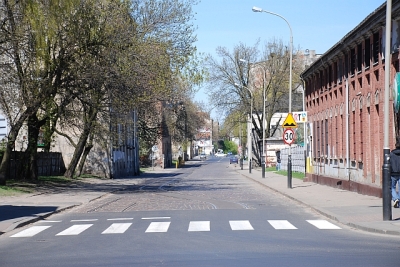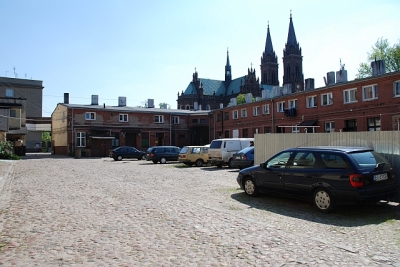It began near Plac Koscielny (Church Square), then it ran along Balucki Rynek (Baluty Market), and stretched to the very border of the ghetto. A number of institutions and departments were located on this street.
For some time, a marketplace functioned at 1 Lagiewnicka St. and at Pieprzowa Street (Pfeffergasse), and life appeared to flourish there as it did before the war. It seemed one could buy and sell almost everything. In the autumn of 1941, Rumkowski decided to close the marketplace at Jojne Pilcer Square and to transform it into a central depot for vegetables. That place, located right next to Plac Koscielny and the tram stop where the goods were transported, was essential for ghetto life. The corner building housed a soup kitchen for physicians.
 This fragment of Lagiewnicka Street looks exactly the same as it did 65 years ago; even I a section of the original cobblestone pavement remains. In fact, Jojne Piker's old corner ! building is now strewed with advertisements, and though it does not look overly attrac! tive these days, the place still houses a number of small shops.
This fragment of Lagiewnicka Street looks exactly the same as it did 65 years ago; even I a section of the original cobblestone pavement remains. In fact, Jojne Piker's old corner ! building is now strewed with advertisements, and though it does not look overly attrac! tive these days, the place still houses a number of small shops.
Key institutions of the ghetto administration were also located at 25 Lagiewnicka St.
(next to Balucki Rynek, opposite the entrance gate of the ghetto) [see: Balucki Rynek]. It is one of the most important buildings of the ghetto era. Several district offices, including, for example, the High Chamber of Control and the Central Trade Committee, operated for some time on the ground floor.
In November 1942, a standard clock with three faces was installed on the roof of the building. It was to facilitate the unification of time in the entire ghetto. Until then, every office or department seemed to have clocks that were seriously out of sync, which resulted in a lot of people showing up late at work. A large open air coal storage was established at Lagiewnicka Street right behind Dworska street [see: Dworska Street].
 From the beginning of the ghetto's existence, Lagiewnicka Street has been a central place of street trade, and the large square abutting it, the so-called Jojne Pilcer Square, was the central marketplace, where food, clothing, haberdashery, ceramics and all kinds of second-hand goods were available. There were kiosks and stalls there, and the trade kept going all day long; a whole army of sellers filled Lagiewnicka Street, stopping traffic and causing a constant disorder with their shouting. In mid-September, Mr. Chairman decided to clean the street of the sellers for the sake of safety and order.
From the beginning of the ghetto's existence, Lagiewnicka Street has been a central place of street trade, and the large square abutting it, the so-called Jojne Pilcer Square, was the central marketplace, where food, clothing, haberdashery, ceramics and all kinds of second-hand goods were available. There were kiosks and stalls there, and the trade kept going all day long; a whole army of sellers filled Lagiewnicka Street, stopping traffic and causing a constant disorder with their shouting. In mid-September, Mr. Chairman decided to clean the street of the sellers for the sake of safety and order.
The Chronicle of the Lodz Ghetto, September 1941, Vol. 1, p. 253.
The German authorities ordered the construction and assembly of a standard clock, which is to be installed at Balucki Rynek (25 Lagiewnicka St.), opposite the entrance to that square.
The Chronicle of the Lodz Ghetto, November 24, 1942, Vol. 2, p. 395.

 Home
Home
